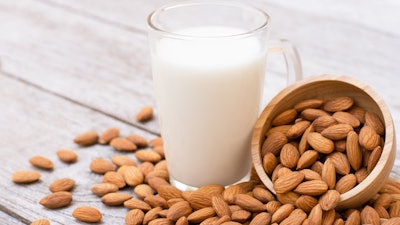
PUNE, INDIA — The Almond Milk Market is projected to grow at a compound annual growth rate (CAGR) of 15.2% in the forecast period from 2022 to 2030.
Almond milk has a number of benefits, including weight loss, antioxidant-rich, lactose-free status, and the ability to strengthen bones. Furthermore, people are likely to switch to plant-based beverages as a result of increased greenhouse gas emissions from dairy cows and their waste. Furthermore, manufacturers are introducing new flavors and high-nutrient content to entice their customers.
COVID-19: Plant-Based Milk Alternatives Spur the Sales
Despite the fact that the pandemic has had a significant impact on consumer buying, eating, and lifestyle choices, sales of plant-based products have increased dramatically. Plant-based milk alternatives such as almond and oat milk have seen an increase in popularity. People have started to consume plant-based goods as a result of a revived interest in fitness and weight loss during the pandemic.
Retail sales of plant-based products increased by roughly 27%, or USD 7 billion, according to a report by the Plant-Based Food Association. Almond milk is the most popular plant-based milk substitute. As a result, demand for almond milk increased significantly throughout the pandemic.
Almond Milk Market by Type - Kinds of Almond Milk Flavors
As the demand for almond-based formulations, blends, and flavors grows, manufacturers will have attractive opportunities to produce novel almond-based formulations, blends, and flavors. Nutrients are essential in almond milk, but flavor and texture are both important. Vanilla, chocolate, unsweetened almond milk, and more tastes are available in the market. As a result, companies have been driven to create new tastes in order to attract more customers. Blue diamond, for example, has a wide range of flavors, including a hint of honey, chocolate, reduced sugar vanilla, and so on.
Almond Milk Market by Packaging Type - Glass Bottles Reduce Landfill Waste
Because of its advantageous features, the glass bottle segment is the most popular. The glass bottle serves as both a marketing tool and an effective milk insulator. The glass bottles aid in the preservation of flavors in a variety of environments. As a result, milk kept in a glass bottle preserves its unique flavor.
Moreover, unlike plastic and paper, glass is easily recyclable and has a longer life cycle with a smaller carbon footprint. The milk bottles can be reused multiple times, reducing the amount of waste sent to landfills. Because today's generation is more aware of the negative impacts caused by waste, they prefer glass bottles than cartons.
Almond Milk Market by Distribution Channel - Supermarkets Stride for Digitization
By the distribution channel, supermarkets and hypermarkets own the largest market share. The manufacturers are improving their network and distribution strategy to reach supermarkets and hypermarkets. The supermarket and hypermarket owners are expanding their product variety to compete online.
The e-commerce segment is expected to grow significantly due to the increasing internet and smartphone penetration. The market competition between supermarkets and e-commerce is expected to depend on the variety of products available.
Almond Milk Market by Application - Surging Demand for Plant-Based Beverages
Beverage, as an application, accounts for the largest share of almond milk. The demand for plant-based beverages is growing in the APAC region, specifically in India and China. The increasing demand for almond beverages is attributed to improved income and health consciousness. Moreover, consumers have become aware of the health benefits of these beverages, and thus, have adopted plant-based beverages. According to the Tetra Pak, the global plant-based beverages market is expected to grow around USD 19.7 billion by 2023.
Almond Milk Market by Regions - Ascendance of Lactose Intolerant Population in North America
North America dominates the almond milk market due to the increasing intolerance for lactose and changing preference towards healthy food among people. North America ranks second in plant-based milk production and was valued at ~USD 4500 million in 2021.
According to the World Atlas, the United Nations tops the production of almonds with around 2,002,742 tons annually. Thus, increasing the production of almond milk every year. For instance, the Almond Breeze brand owned by Blue Diamond saw around a 17% increase in retail sales in August 2020.






















